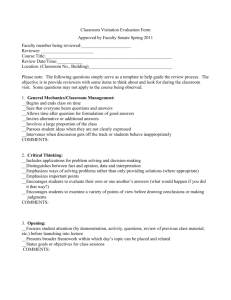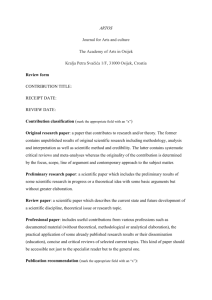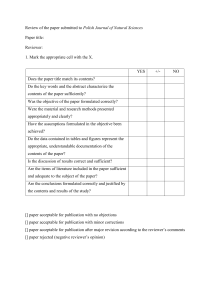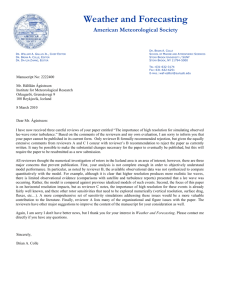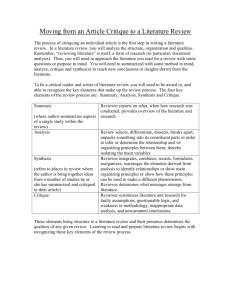Paper Review Form Instructions - International Energy Policy
advertisement
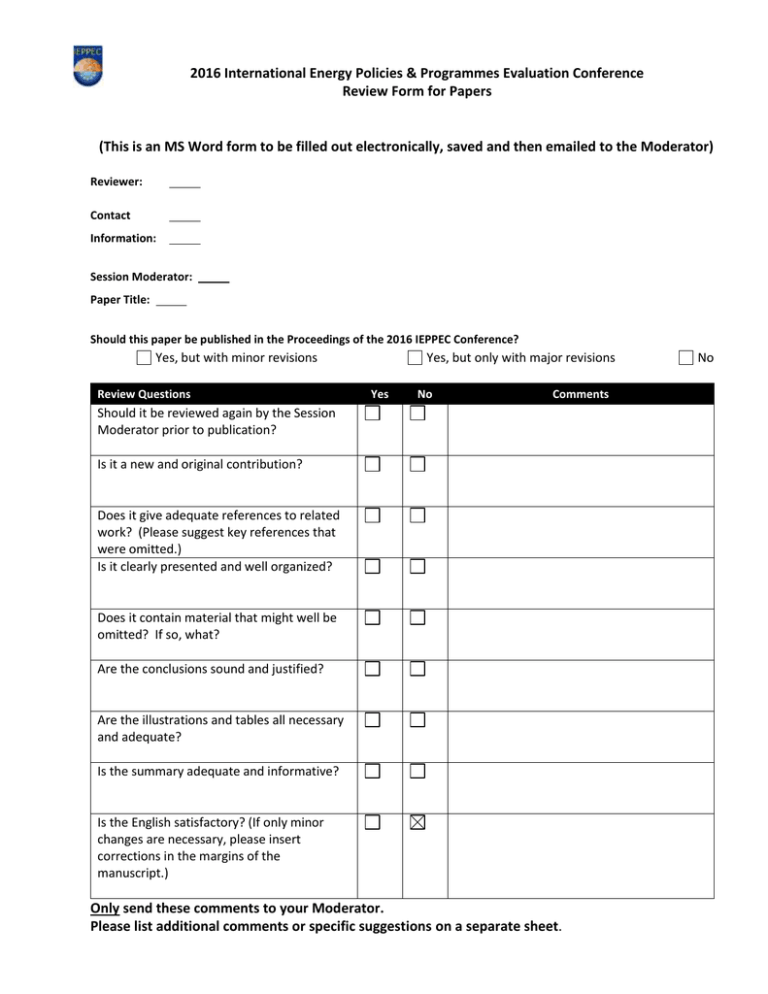
2016 International Energy Policies & Programmes Evaluation Conference Review Form for Papers (This is an MS Word form to be filled out electronically, saved and then emailed to the Moderator) Reviewer: Contact Information: Session Moderator: Paper Title: Should this paper be published in the Proceedings of the 2016 IEPPEC Conference? Yes, but with minor revisions Review Questions Yes, but only with major revisions Yes No Comments Should it be reviewed again by the Session Moderator prior to publication? Is it a new and original contribution? Does it give adequate references to related work? (Please suggest key references that were omitted.) Is it clearly presented and well organized? Does it contain material that might well be omitted? If so, what? Are the conclusions sound and justified? Are the illustrations and tables all necessary and adequate? Is the summary adequate and informative? Is the English satisfactory? (If only minor changes are necessary, please insert corrections in the margins of the manuscript.) Only send these comments to your Moderator. Please list additional comments or specific suggestions on a separate sheet. No Criteria For Review RELEVANCE The topic of the papers in the Conference proceedings must match the focus of the Conference. The Conference serves its participants as a forum for the presentation and discussion of important evaluation results, issues, methodologies, implementation, techniques or applications as they apply to conference topics. Conference topics include: customer marketing; energy products & services; customers & customer behavior; performance management; evaluation ethics, standards & practices; evaluation designs, implementation and results; competitive intelligence & benchmarking; energy efficiency in a competitive market; and electric reliability issues. Reviewers must judge acceptability of Conference papers based on these issues. ORIGINALITY The paper must reflect original work done by the author. The reviewer is to determine if the work reported is original and if, to his knowledge, it has been published elsewhere. If the paper is a summary or other synthesis paper, the reviewer must indicate if he knows of any similar sorts of syntheses. SIGNIFICANCE The paper must represent a significant contribution to the field. The reviewer is to identify the contribution made by the author and comment on it. Works of low significance may be dropped or reduced in size. ACCURACY The paper’s content must be accurate. The reviewer is to judge the soundness of the research, including assumptions, approach, design, and analysis. The reviewer should point out weaknesses, suggest changes, and indicate the severity of each criticism. CLARITY The information in the paper must also be clearly communicated. The reviewer is to suggest improvements to the text, commenting on its readability and indicating whether the information would be clearly understood by the readership. The reviewer must also identify any extraneous material that could result in condensing the text. COMPLETENESS The paper should be self-sufficient with adequate references to relevant works. The reviewer is to note any lack of completeness and identify appropriate additional information. OVERALL RATING The reviewer can make additional comments and should give an overall rating to the paper. 2 Guidelines For Reviewers Peer review of proceedings papers and other technical reports is a key element in maintaining academic integrity. These reviews (sometimes called “referees”) play a key role in contributing constructive criticism to the author. The following offers some tips to the reviewer to assist in the preparation of a written review. Learning the mechanics of review writing can never substitute for a full comprehension of the material, but it can transform the review into a constructive document. At the same time, there are simple rules to identify flaws in the paper that greatly simplify review preparation and allow the reviewer to concentrate on the paper’s content. The peer review serves several purposes, although the precise combination varies with the type of review. The most important reasons for review include finding deficiencies in: technical approach and analysis computation ignorance of related research Each of these categories requires a reviewer with broad knowledge of the topic to recognize these deficiencies. Even simple arithmetic errors need an expert to detect. Errors of the “2 x 3 = 7" type are rarely spotted directly; rather, a reviewer will sense that something is wrong with an argument, and then trace it back to the arithmetic error. No self-respecting researcher wants such errors publicized, so the review process limits the humiliation to a much smaller (and often anonymous) circle. Reviews are also useful to detect style and grammar that confuse the reader and patent or legal issues. The reviewer should alert the author to style and grammar errors, especially if they are serious. Certainly the author wants his or her paper read, understood, and appreciated by as many people as possible; therefore, it is in his interest to repair these problems before the paper is published or circulated. WHAT MAKES A GOOD PAPER? Good papers contain something of merit. You, an expert on the subject, should be able to find it (if it exists). However, the item of merit may be poorly presented, which can undermine the paper’s value. A logical structure is the first element of a good presentation. A standard structure for technical papers has evolved and is given below. 1. Abstract 2. Introduction 3. Body of the paper • Background • Scope - Methodology [surveys and data processing (if used)] - Results 4. Conclusions 5. ReferencesTables 6. Figures (and captions) 3 Naturally, there are minor variations depending on the topic, but the concept is always the same. If the author did not follow it, then it should be obvious to a reader why a different structure was necessary. Even if the paper was written in the standard structure, major problems may exist (the standard structure simplifies identification of the defects). Here are some common errors encountered in each of the sections: Read the Abstract before and after the whole paper. Does it actually summarize the paper? Does it include the conclusions as well as the statement of the original problem? Is there information not presented elsewhere in the paper? Keep in mind that abstracts are often written in haste, sometimes not by the principal author, and occasionally with knowledge of information not discussed in the paper. The Introduction should explain why the topic is important. The audience for the paper will determine the scope of the Introduction. Many technical papers suffer from excessively broad introductions; usually the first few paragraphs can be excised. Does the author cite only his own papers for examples of past work? The Body of the paper is the part most requiring the reviewer’s expertise. Here you are on your own. As you read it, decide if the approach and analysis are clearly described. Has the author integrated discussions of errors and uncertainties in his analysis at suitable points? Authors also have difficulty identifying what parts of their papers are central and which are either irrelevant or of lesser importance (sometimes the author has not carefully considered his audience). Therefore, look for material that could be deleted. Is the level of detail reasonable? Is too much data presented? Many papers are condensed from longer, detailed internal reports. It is perfectly acceptable to refer to the internal reports for details, especially when only a few readers will be interested (if they want the details, they can write the author for the report). When the paper has a page limit, the author may fail to insert enough detail. As a reviewer, you need to identify these cases and suggest areas where offsetting deletions could be made so as to remain within the limits. While reading the Body of the paper, consider the topic as a whole. Is this the right amount of work for a paper? Is the paper premature? Alternatively, should the paper be divided into two papers? Few reviewers seriously consider these issues. The Conclusion should follow directly from the Body of the paper. There should be no surprises, and most important, no new material introduced. Some authors try to broaden their conclusions by “reaching” for results produced elsewhere. This is unacceptable. The References provide many clues to the author’s approach. The paper is immediately suspect (but not necessarily wrong or obsolete) if all of the references are old. A 4 Reference list containing papers only by the author deserves special, and skeptical scrutiny. Beyond this, however, the reviewer should be able to spot omissions. Has the author forgotten important references? Help the author if possible by supplying citations. Tables, Graphs, and Figures are vital components to a paper but only when thoughtfully used. Tables are particularly abused. Is every table and graph necessary? Perhaps a citation to an internal report would suffice. Do the tables contain more digits than are actually significant? This is a common problem when computers calculate values and the programmers fail to suppress insignificant digits. Worse, these nonsense numbers clutter up a table, thus making it more difficult for the reader to extract the significant numbers. Zero suppression also removes table clutter. Substitution of graphs for tables avoids both of these problems. Can the table data be presented better in a graph? With the advent of computer plotting programs, graphs are easy to create. Unfortunately, some treat a graph as a piece of art and refuse to acknowledge that most graphs will be computer generated. You must recognize that a compromise may be required. Check that all figures and tables are appropriately captioned and are referred to in the text. It is good practice to have one sentence in the caption summarizing the results. WHEN TO DECLINE Reviewers must finish a review within a specified time. Unfortunately, a good review takes many hours to prepare and it must compete with other obligations. Therefore, you can (and should) decline to review a paper if you cannot devote the necessary time before the deadline. Upon inspection of the paper, you may realize that you are not competent to review the paper. This is nothing to be concerned about because papers and reviewers cannot be perfectly matched. When you decline to review a paper, suggest an alternate reviewer. Be sure to provide the alternate’s name, address, phone number, and e-mail address. HOW TO SUBMIT REVIEW COMMENTS TO YOUR MODERATOR The form for reviewer comments consists of a set of questions related to specific criteria that the editor uses to make decisions. These questions should be answered as fully as possible. Additionally, there is an opportunity to provide general comments and specific suggestions. 5

